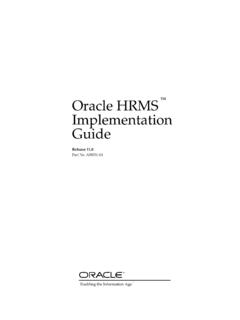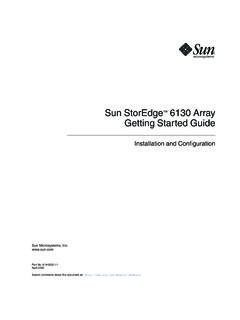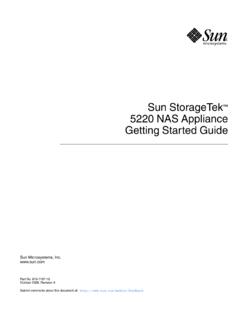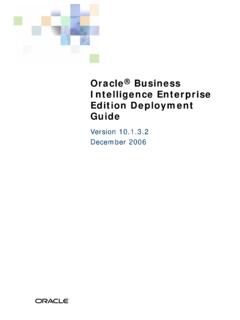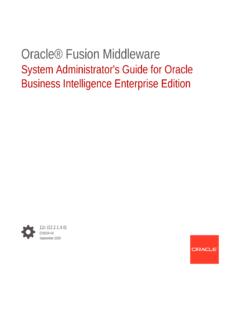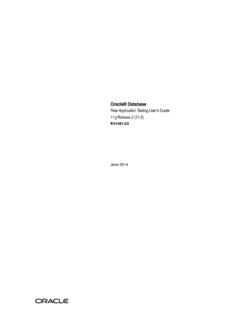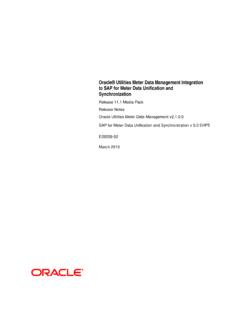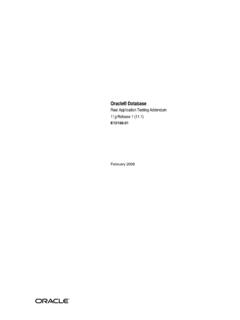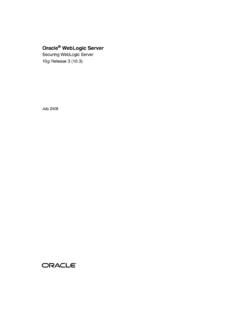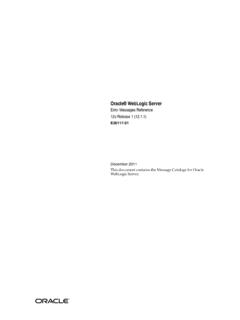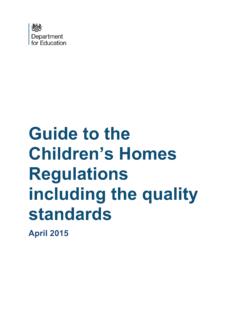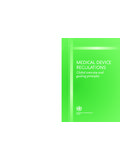Transcription of Database Performance Tuning Guide - Oracle
1 Oracle DatabaseDatabase Performance Tuning Guide19cE96347-04 April 2020 Oracle Database Database Performance Tuning Guide , 19cE96347-04 Copyright 2007, 2020, Oracle and/or its Authors: Glenn MaxeyPrimary Authors: Rajesh Bhatiya, Immanuel Chan, Lance AshdownContributors: Hermann Baer, Deba Chatterjee, Maria Colgan, Mikael Fries, Prabhaker Gongloor, KevinJernigan, Sue K. Lee, William Lee, David McDermid, Uri Shaft, Oscar Suro, Trung Tran, Sriram Vrinda, YujunWangThis software and related documentation are provided under a license agreement containing restrictions onuse and disclosure and are protected by intellectual property laws. Except as expressly permitted in yourlicense agreement or allowed by law, you may not use, copy, reproduce, translate, broadcast, modify,license, transmit, distribute, exhibit, perform, publish, or display any part, in any form, or by any engineering, disassembly, or decompilation of this software, unless required by law forinteroperability, is information contained herein is subject to change without notice and is not warranted to be error-free.
2 Ifyou find any errors, please report them to us in this is software or related documentation that is delivered to the Government or anyone licensing it onbehalf of the Government, then the following notice is GOVERNMENT END USERS: Oracle programs (including any operating system, integrated software,any programs embedded, installed or activated on delivered hardware, and modifications of such programs)and Oracle computer documentation or other Oracle data delivered to or accessed by Government endusers are "commercial computer software" or commercial computer software documentation pursuant to theapplicable Federal Acquisition Regulation and agency-specific supplemental regulations. As such, the use,reproduction, duplication, release, display, disclosure, modification, preparation of derivative works, and/oradaptation of i) Oracle programs (including any operating system, integrated software, any programsembedded, installed or activated on delivered hardware, and modifications of such programs), ii) Oraclecomputer documentation and/or iii) other Oracle data, is subject to the rights and limitations specified in thelicense contained in the applicable contract.
3 The terms governing the Government s use of Oracle cloudservices are defined by the applicable contract for such services. No other rights are granted to the software or hardware is developed for general use in a variety of information management is not developed or intended for use in any inherently dangerous applications, including applications thatmay create a risk of personal injury. If you use this software or hardware in dangerous applications, then youshall be responsible to take all appropriate fail-safe, backup, redundancy, and other measures to ensure itssafe use. Oracle Corporation and its affiliates disclaim any liability for any damages caused by use of thissoftware or hardware in dangerous and Java are registered trademarks of Oracle and/or its affiliates. Other names may be trademarks oftheir respective and Intel Inside are trademarks or registered trademarks of Intel Corporation. All SPARC trademarks areused under license and are trademarks or registered trademarks of SPARC International, Inc.
4 AMD, Epyc,and the AMD logo are trademarks or registered trademarks of Advanced Micro Devices. UNIX is a registeredtrademark of The Open software or hardware and documentation may provide access to or information about content, products,and services from third parties. Oracle Corporation and its affiliates are not responsible for and expresslydisclaim all warranties of any kind with respect to third-party content, products, and services unless otherwiseset forth in an applicable agreement between you and Oracle . Oracle Corporation and its affiliates will not beresponsible for any loss, costs, or damages incurred due to your access to or use of third-party content,products, or services, except as set forth in an applicable agreement between you and PrefaceAudiencexviiiDocumentation AccessibilityxviiiRelated DocumentsxixConventionsxix Changes in This Release for Oracle Database Performance TuningGuideChanges in Oracle Database Release 19c, Version in Oracle Database Release 18c, Version in Oracle Database 12c Release 2 ( )xxiChanges in Oracle Database 12c Release 1 ( )xxiiChanges in Oracle Database 12c Release 1 ( )
5 XxiiiPart I Database Performance Fundamentals1 Performance Tuning OverviewIntroduction to Performance Tuning1-1 Performance Planning1-1 Instance Tuning1-1 Performance Principles1-2 Baselines1-2 The Symptoms and the Problems1-2 When to Tune 1-3 SQL Tuning1-4 Query Optimizer and Execution Plans1-4 Introduction to Performance Tuning Features and Tools1-5 Automatic Performance Tuning Features1-5 Additional Oracle Database Tools1-6iiiV$ Performance Views1-62 Designing and Developing for PerformanceOracle Methodology2-1 Understanding Investment Options2-1 Understanding Scalability2-2 What is Scalability?2-2 System Scalability2-3 Factors Preventing Scalability2-4 System Architecture2-5 Hardware and Software Components2-5 Hardware Components2-5 Software Components2-6 Configuring the Right System Architecture for Your Requirements2-7 Application Design Principles2-10 Simplicity In Application Design2-10 Data Modeling2-10 Table and Index Design2-11 Appending Columns to an Index or Using Index-Organized Tables2-11 Using a Different Index Type2-11 Finding the Cost of an Index2-12 Serializing within Indexes2-13 Ordering Columns in an Index2-13 Using Views2-13 SQL Execution Efficiency2-14 Implementing the Application 2-15 Trends in Application Development2-17 Workload Testing, Modeling, and Implementation2-17 Sizing Data2-18 Estimating Workloads2-18 Application Modeling2-19 Testing, Debugging.
6 And Validating a Design2-19 Deploying New Applications2-20 Rollout Strategies2-20 Performance Checklist2-213 Performance Improvement MethodsThe Oracle Performance Improvement Method3-1 Steps in the Oracle Performance Improvement Method3-2ivA Sample Decision Process for Performance Conceptual Modeling3-3 Top Ten Mistakes Found in Oracle Systems3-4 Emergency Performance Methods3-6 Steps in the Emergency Performance Method3-64 Configuring a Database for PerformancePerformance Considerations for Initial Instance Configuration4-1 Initialization Parameters4-2 Undo Space4-3 Redo Log Files4-4 Tablespaces4-4 Creating and Maintaining Tables for Optimal Performance4-6 Table Compression4-6 Reclaiming Unused Space4-8 Indexing Data4-8 Performance Considerations for Shared Servers4-9 Identifying and Reducing Contention Using the Dispatcher-Specific Views 4-10 Identifying Contention for Shared Servers4-11 Improved Client Connection Performance Due to Prespawned Processes4-12 Part II Diagnosing and Tuning Database Performance5 Measuring Database PerformanceAbout Database Statistics5-1 Time Model Statistics5-1 Active Session History Statistics5-2 Wait Events Statistics5-3 Session and System Statistics5-4 interpreting Database Statistics5-5 Using Hit Ratios5-5 Using Wait Events with Timed Statistics5-5 Using Wait Events without Timed Statistics5-6 Using Idle Wait Events5-6 Comparing Database Statistics with Other Factors5-6 Using Computed Statistics5-76 Gathering Database StatisticsAbout Gathering Database Statistics6-1vAutomatic Workload Repository6-2 Snapshots6-2 Baselines6-3 Fixed Baselines6-3 Moving Window Baselines6-3 Baseline Templates6-4 Space Consumption6-4 Adaptive Thresholds6-6 Percentage of Maximum Thresholds6-6 Significance Level Thresholds6-6 Managing the Automatic Workload Repository6-7 Enabling the Automatic Workload Repository6-8 Managing Snapshots6-8 User Interfaces for
7 Managing Snapshots6-9 Creating Snapshots6-9 Dropping Snapshots6-10 Modifying Snapshot Settings6-11 Managing Baselines6-12 User Interface for Managing Baselines6-12 Creating a Baseline6-13 Dropping a Baseline6-14 Renaming a Baseline6-15 Displaying Baseline Metrics6-15 Resizing the Default Moving Window Baseline6-15 Managing Baseline Templates6-16 User Interfaces for Managing Baseline Templates6-17 Creating a Single Baseline Template6-17 Creating a Repeating Baseline Template6-18 Dropping a Baseline Template6-18 Transporting Automatic Workload Repository Data to Another System6-19 Exporting AWR Data6-19 Importing AWR Data6-20 Using Automatic Workload Repository Views6-21 Managing Automatic Workload Repository in a Multitenant Environment6-23 Categorization of AWR Data in a Multitenant Environment6-23 AWR Data Storage and Retrieval in a Multitenant Environment6-24 Viewing AWR Data in a Multitenant Environment6-26 Managing Automatic Workload Repository in Active Data Guard StandbyDatabases6-28 Configuring the Remote Management Framework (RMF)
8 6-29 Managing Snapshots for Active Data Guard Standby Databases6-34viViewing AWR Data in Active Data Guard Standby Databases6-36 Generating Automatic Workload Repository Reports6-37 User Interface for Generating an AWR Report6-37 Generating an AWR Report Using the Command-Line Interface6-37 Generating an AWR Report for the Local Database6-38 Generating an AWR Report for a Specific Database6-39 Generating an AWR Report for the Local Database in Oracle RAC6-40 Generating an AWR Report for a Specific Database in Oracle RAC6-41 Generating an AWR Report for a SQL Statement on the Local Database6-42 Generating an AWR Report for a SQL Statement on a Specific Database6-43 Generating Performance Hub Active Report6-44 Overview of Performance Hub Active Report6-44 About Performance Hub Active Report Tabs6-45 About Performance Hub Active Report Types6-46 Command-Line User Interface for Generating a Performance Hub Active Report6-46 Generating a Performance Hub Active Report Using a SQL Script6-467 Automatic Performance DiagnosticsOverview of the Automatic Database Diagnostic Monitor7-1 ADDM Analysis7-2 Using ADDM with Oracle Real Application Clusters7-4 Using ADDM in a Multitenant Environment7-4 Enabling ADDM in a Pluggable Database7-6 Real-Time ADDM Analysis7-7 Real-Time ADDM Connection Modes7-7 Real-Time ADDM Triggers7-7 Real-Time ADDM Trigger Controls7-8 ADDM Analysis Results7-9 Reviewing ADDM Analysis Results.
9 Example7-10 Setting Up ADDM7-11 Diagnosing Database Performance Problems with ADDM7-11 Running ADDM in Database Mode7-12 Running ADDM in Instance Mode7-13 Running ADDM in Partial Mode7-13 Displaying an ADDM Report7-14 ADDM Views7-148 Comparing Database Performance Over TimeAbout Automatic Workload Repository Compare Periods Reports8-1viiGenerating Automatic Workload Repository Compare Periods Reports8-2 User Interfaces for Generating AWR Compare Periods Reports8-2 Generating an AWR Compare Periods Report Using the Command-LineInterface8-3 Generating an AWR Compare Periods Report for the Local Database8-3 Generating an AWR Compare Periods Report for a Specific Database8-4 Generating an Oracle RAC AWR Compare Periods Report for the LocalDatabase8-5 Generating an Oracle RAC AWR Compare Periods Report for a SpecificDatabase8-6 interpreting Automatic Workload Repository Compare Periods Reports8-8 Summary of the AWR Compare Periods Report8-9 Snapshot Sets8-9 Host Configuration Comparison8-9 System Configuration Comparison8-9 Load Profile8-9 Top 5 Timed Events8-9 Details of the AWR Compare Periods Report8-9 Time Model Statistics8-10 Operating System Statistics8-10 Wait Events8-10 Service Statistics8-11 SQL Statistics8-11 Instance Activity Statistics8-13I/O Statistics8-13 Advisory Statistics8-14 Wait Statistics8-14 Undo Segment Summary8-15 Latch Statistics8-15 Segment Statistics8-15In-Memory Segment Statistics8-16 Dictionary Cache Statistics8-16 Library Cache Statistics8-17 Memory Statistics8-17 Advanced Queuing Statistics8-18 Supplemental Information in the AWR Compare Periods Parameters8-18 Complete List of SQL Text8-189 Analyzing Sampled DataAbout Active Session History9-1viiiGenerating Active Session History Reports9-2 User Interfaces for Generating ASH Reports9-3 Generating an ASH Report Using the Command-Line Interface9-3 Generating an ASH Report on the Local Database Instance9-3
10 Generating an ASH Report on a Specific Database Instance9-4 Generating an ASH Report for Oracle RAC9-5 interpreting Results from Active Session History Reports9-7 Top Events9-7 Top User Events9-8 Top Background Events9-8 Top Event P1/P2/P39-8 Load Profile9-8 Top Service/Module9-8 Top Client IDs9-8 Top SQL Command Types9-8 Top Phases of Execution9-9 Top SQL9-9 Top SQL with Top Events9-9 Top SQL with Top Row Sources9-9 Top SQL Using Literals9-9 Top Parsing Module/Action9-9 Complete List of SQL Text9-9 Top PL/SQL9-10 Top Java9-10 Top Sessions9-10 Top Sessions9-10 Top Blocking Sessions9-10 Top Sessions Running PQs9-10 Top Objects/Files/Latches9-10 Top DB Objects9-11 Top DB Files9-11 Top Latches9-11 Activity Over Time9-1110 Instance Tuning Using Performance ViewsInstance Tuning Steps10-1 Define the Problem10-2 Examine the Host System10-2 CPU Usage10-3 Identifying I/O Problems10-4ixIdentifying Network Issues10-6 Examine the Oracle Database Statistics10-7 Setting the Level of Statistics Collection10-7 Wait Events10-8 Dynamic Performance Views Containing Wait Event Statistics10-9 System Statistics10-10 Segment-Level Statistics10-11 Implement and Measure Change10-12 interpreting Oracle Database Statistics10-12 Examine Load10-12 Using Wait Event Statistics to Drill Down to Bottlenecks10-13 Table of Wait Events and Potential Causes10-15 Additional Statistics10-16 Wait Events Statistics10-18 Changes to Wait Event Statistics from Past Releases10-19buffer busy waits10-21db file scattered read10-23db file sequential read10-24direct path read and direct path read temp10-26direct path write and direct path write temp10-27enqueue (enq.)
